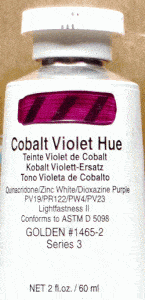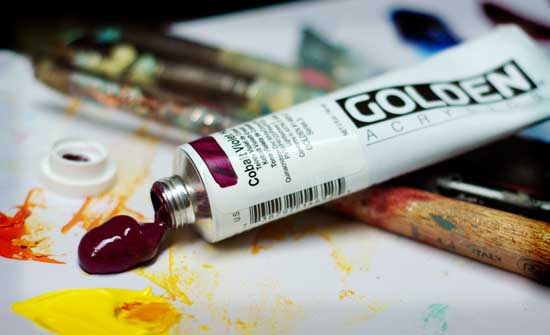A brief overview of Artists’ vs Student quality paint
There are usually two grades of colour available, artist quality and student quality.
But what is the difference?
And, is it worth the cost?
When first starting painting lessons it is often overwhelming to try and decide which brush to buy, what canvas to paint on and the biggest choice of all. What paints to buy!
Your paints can help greatly in your progress as a painter, what usually happens is a hesitancy on investing in the ‘good quality’ paints until you yourself become a better painter.
This is a mistake.
One of the key things to understand is the labelling and differences between artist and student quality paint and how better quality paint, can make your life as a painter much easier…
Artist quality
- Highest pigment levels
- Varied price range
- Widest choice of colour
- Limited colour shift
Student Quality
- Less paint coverage
- More affordable price range
- Greater colour shift
- Good for large scale painting and under-painting
It should be simple, but sometimes all the information on a paint tube can be confusing.
With a few easy tips, you will soon know your phthalo from your quinacridone.
1. Price
Paint pigments can be expensive and vary in cost. Manufacturers group colours into various price bands depending on the amount of the raw material and what the raw material is.
The binder (acrylic polymer) is relatively inexpensive in comparison. That is why artist quality paints are split into series.(e.g. Series A, Series B) and others numbers (e.g. Series 1, Series 2). The higher the letter or number, the more expensive the paint.
e.g. Cadmium red is an expensive raw material so is series 9 (highest price) whereas burnt umber is relatively inexpensive so is series 1 (cheapest price).
It is important to note that in Student quality paints you can only get series 1 and 2.
Hue
“So, can you not get Cadmium red in student quality paint?” I hear you ask, well you can get Cadmium Red Hue.
When you see “hue” written on a paint tube it means imitation, not a pure Cad red pigment but a combination of cheaper available reds to make a colour very close. So you can imagine it’s never going to have the colour saturation that an artist grade paint will have, however, for pigments that are manufactured to resemble historical colours they can also be called ‘hue.
For example, ‘Alizarin Crimson Hue’ from Golden paints is a modern artist grade paint that is trying to replicate historical Alizarin Crimson.
Golden have substitued a mix of quinacridone and phthalo modern pigments to substitute a traditional Rose Madder.
2. Coverage
This is how easily a paint colour covers another paint colour, for example, a black paint will cover a yellow easier than the yellow will cover the black.
3. Opacity
Pigments vary in their transparency by nature, different paints have difference levels of opacity depending on the paint pigments chemical make up.
So a paint made from earth, such as an ochre will be made from crushed up rock, this, of course, is hard to see through! So will make a paint that has pretty good coverage.
If you were using a paint that the pigments comes from a dye or is man-made, such as a quinacridone, (called synthetic organics) the thinner and more translucent a paint will be.
They are often labelled on a paint tube, for example, Winsor & Newton use the following abbreviations:
- T for transparent colours
- ST for semi-transparent colours
- SO semi-opaque colours
- O opaque colours
Pro tip: It is very handy to understand the differences so if you want to make a super translucent glaze, the quinacridones are perfect for glazing (thin layer of paint)
A rule of thumb is if you can’t pronounce the name it is usually a transparent paint. If it sounds more ‘earthy’ it will be more opaque.
Transparent colours are used for glazing and tinting.
Opaque colours cover other paints easily and are great for making solid, flat areas of colour and covering up any mistakes you’ve made.
4. Paint sample
On most artist quality paints, there will be a colour swatch of the actual paint on the exterior of the tube. This is really helpful when deciding which paints will suit your needs.
5. Colour range
Artist grade paints have a larger choice of colours available.
6. Paint consistency
In some ranges of artist quality paints, such as Golden Acrylics, the manufacturer offers a range of different paint consistencies, this is unique to acrylics.
Different binders are available in different consistencies so you can have a thick paint or thin paint but the thinnest paint will have as much pigment as the thicker paint.
This can be very useful.
If you want a solid colour to cover your canvas but still want to leave a ‘tooth’ on your canvas, use fluid acrylics. It will give you a deep, rich colour without the diluted, watery effect which you would have if you thinned a thicker paint with water.
Paint consistency range
- Heavy body acrylic
- Fluid acrylic
- Airbrush acrylic
7. Colour shift
In acrylics the colour of the paint when wet changes when it dries, it goes slightly darker.
This is due to the binder (acrylic polymer) that is usually used, being white.
The acrylic emulsion is white when wet but becomes clear as it dries. As a result, it darkens.
Pro tip: If you like adding mediums to your acrylics to increase drying time be careful of the increased colour shift because acrylic medium is just like adding more binder-more white so the colour shift will be more pronounced.
Winsor & Newton artist acrylic use a clear binder and claim no colour shift but I have found there is still a little colour shift, but not as noticeable.
In student quality paints a white binder will have been used and often the cheaper you go the greater the colour shift.
” It makes it harder for the beginner to accurately mix the colour they want, not from lack of trying but using the wrong materials.”
8. Tinting strength
This refers to how much or how little paint is needed to alter the colour of white paint.
So if you used phthalo blue (high tinting strength) you would only need a very little amount of paint to drastically change the white. In comparison to say Terre Verte which has a very low tinting strength.
So for bright, colourful abstracts Terre Verte would be the wrong choice, but for toning down a bright pink in your portrait painting palette, Terre Verte would be perfect.
The Fundamental Information on a Paint Tube Label

- Manufacturer’s name – Golden, Liquitex, Winsor & Newton
- Common name for the colour – Cadmium Red
- Manufacturer’s name of colour – e.g.Winsor blue,
- Names of the pigment(s)
- Color index name/number(s)
- The vehicle the pigment is suspended in (e.g. acrylic polymer emulsion for acrylic paint, or gum arabic for watercolour and gouache).
- Lightfastness or permanence rating – AA and A rated and are recommended as permanent for artists’ use.
- Quantity of paint in tube or jar – e.g. 60ml
- Series – Manufacturers group colours into various price bands depending on the cost of the raw material.
- Paint swatch of actual paint– this is great to be able to see the consistency of the pigment.
- Permanence – paints are rated on their permanence to light
For beginners, that’s about enough information that you need to know for an informed choice to get started but for the paint geeks there’s more detailed information below:
1. Pigment colour – Often paint colours that are almost exactly the same are called different names depending on the manufacturer. One companies ‘yellow ochre’ is other companies ‘yellow ochre pale’ they also name the colour depending on their brand. Winsor & Newton ‘Winsor blue’ has the same chemical properties as golden ‘phaltho blue green’.
Although the pigment chemical names will be the same there will be subtle differences in shade.
You can be a paint detective though by understanding the colour index of pigments.
2. Colour Index Number– The label on a tube of paint should tell you what pigment(s) it contains. Many of the more exotic named paint colours are simple a mix of two or more existing colours.
Student quality paints don’t tell you this information.
3.Color Index Name -Every pigment has a unique colour index name, it consists of:
Two letters. These stand for the colour family, e.c PB – blue, PG- green
And some numbers. Which identifies the pigment. For example:
Golden Heavy Body Acrylic
Manufacturer name – C.P Cadmium Red Light
Chemical name – Cadmium sulphoselenide
Chemical index number – PR 108
PR108 is PR(red) 108 (Seleno-Sulfide) more commonly known as cadmium red
Golden Heavy Body Acrylic
Manufacturer name – Alizarin Crimson Hue
Chemical Name – Quinacridone, Chlorinated Copper Phthalocyanine
Chemical index number -PR122/PR206/PG7
4. Quality standard information -Paints made in the USA have information regarding conformance to various ASTM standards:
e.g. ASTM D4236 (Standard Practice for labelling Art Materials for Chronic Health Hazards)
D4302 (Standard Specification for Artist’s Oil, Resin-Oil, and Alkyd Paints)
D5098 (Standard Specification for Artist’s Acrylic Dispersion paints), as well as the required health warnings
You might also like:
So now you know the differences what should you buy?
1. How to choose a basic acrylic palette
2. How to choose a basic oil portrait painting palette
Resources:
The Artist’s Handbook by Pip Seymour. This book goes into great details on the various properties of each individual pigment
Empty Easel Professional Grade Oil paint vs Student Grade oil paint review

